by Ryan Tilley, Fort Vancouver Rose Society, Consulting Rosarian
We had a very warm winter on both coasts in 2019-20 this past winter and you know what that means Bugs. It is a shame really that just about every bug known to man passes through our rose garden buffet and stuffs themselves silly before moving on. And there isn’t even a sneeze guard.
But fear not as there are many insect predators that eat the bad bugs. Unfortunately there are not enough good insects to in most cases to keep our buds, blooms, and leaves from being eaten and sucked dry. But they do help enough that you don’t have to worry about every single insect on your roses. Many insects are just passing by and will possibly be gone by the time you notice the damage and mix up a pesticide.
The main reason I always give for using as little insecticides as possible. You will be killing the good bugs as well as the bad bugs. This in turn screws up Mother Nature and makes the problem worse as you move forward and head into summer. Of course there are some occasions when spraying is a must to deal with an unholy hoard of thrips, mites, aphids, and/or cucumber beetles. Be kind by only spraying the tops of the bushes if possible because that is where most of the damage will be done.
Spider-mites are an exception as they must be controlled over the whole bush with a miticide like Avid, Tetra San, Floramite and others. Since you spray the undersides of the leaves to get rid of thrips, the whole bush will likely get wet. But no worries. Miticides are not supposed to kill beneficial insects.
So, here is a list of critters that you should welcome into your garden. If you see them on your roses, For God’s sake don’t kill them!
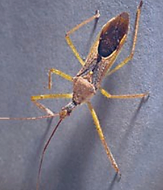
Assassin Bug
How to recognize :This aptly-named, vicious-looking bug is about 1/4 to one inch long, with a cone-shaped head and wide curving beak. They may cause a painful bite to a human if captured. Some species squeak if caught. Females lay single eggs in cracks, under rocks or in other sheltered spots in summer, and new adults emerge around the following June. There is only one generation per year.
Benefits : Assassin bugs are voracious predators of many garden pests including flies, mosquitoes, beetles and large caterpillars.
Fun fact : Adult and nymph assassin bugs stab their prey with long, pointed “beaks” that are held folded under their bodies while not feeding.
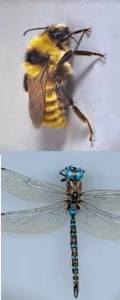
Bumble Bee
How to recognize Large and lumbering, black and yellow bumble bees measure up to one inch in length.
These fuzzy insects make a loud droning buzz as they fly somewhat awkwardly from flower to flower. Bumble bees nest in soil or leaf litter where a single queen lays 8 to 12 eggs in spring and continues to lay eggs through the summer.
Benefits : Emerging workers are able to fly in very cool weather, making them a very valuable pollinator of a variety of plants.
How to attract As these bees nest in soil and leaf litter, try to leave a section of your yard undisturbed. A little “wild” place in your yard can offer a haven for many other beneficial insects that would otherwise be killed by tilling and mowing. Provide native flowers, as they are a primary food source.
Dragon Fly (above)
How to recognize : There are more than 80 species in Washington. They can be identified by their long narrow body, their large compound eyes and the four transparent wings. There is variation in color. Sizes range from one to two inches. The larvae are found in water.
Benefits : They eat mosquitoes, aphids and other bad bugs. I had a pool in Atlanta as well as here in Vancouver and if you take the time to notice you may often see Dragon Flies zipping in the airspace above the pool blissfully eating their fill of bugs, hopefully just the bad guys.

Green Lacewing
How to recognize : Adult green lacewings have delicate, light green bodies; large clear wings; and bright golden or copper colored eyes. They are 1/2 to 3/4 inch long. The larvae are small, grayish brown, and narrow and they have pincerlike mandibles. Eggs are found on plant stems and foliage; they are laid singly or in small groups on top of fine, silken stalks.
Benefits : Lacewing larvae and adults feed voraciously upon aphids and other small insects, insect eggs, and spider mites. They also eat leafhopper nymphs, whiteflies and small caterpillars.
How to attract Plant flowers that produce pollen and nectar. Adults are mobile, but lay eggs where they stop to eat.
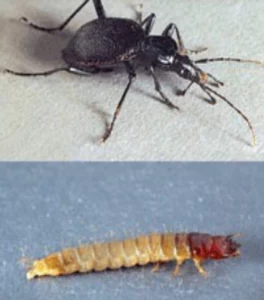
Ground Beetle
How to recognize : While shapes and colors may vary widely, they are usually shiny. Some are very ferocious-looking, but they are not known to bite people. Black is a common color, sometimes with a metallic sheen of another color on their wing covers. Most ground beetles feed at night and hide in the soil or under debris during the day. Adult beetles range from 1/8 to one inch long.
Benefits: These very common garden insects feed on many soil-inhabiting pests such as cutworms and root maggots. Some types eat slugs and snails.
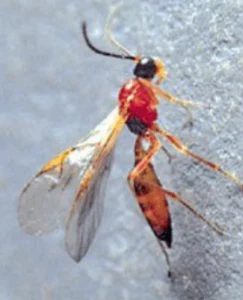
Parasitic Wasp
The mere mention of wasps makes me cringe as I remember running from huge paper nests as big as watermelons that I stumbled onto while pruning the inside large shrubs. But these wasps will not harm you.
How to recognize : Too small to be noticeable, these mini-wasps don’t sting people or pets. They range in size from the smallest insect known (about 1/50 inch) to about one inch, although most are on the small side. These parasites reproduce by laying their eggs in a pest host (adult or egg). The immature wasp feeds inside and kills its host. A round hole can be often seen where the adult parasite has chewed its way out.
Benefits : Different species may attack aphids, whiteflies, and butterflies or moths, such as cabbage loopers and hornworms.
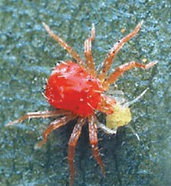
Predatory Mite
How to recognize : Adult mites are tiny, about half a millimeter in length, and are beige to reddish tan. They resemble pest mites but are faster moving and have fewer hairs.
Benefits : Predatory mites are valuable predators of pest mites such as spider mites.
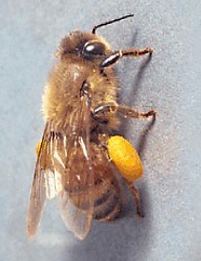
Honey Bee
How to recognize – Adults measure 2/3 inch long and are fuzzy, with gold-and-black striped bodies and transparent wings. Honey bees can often be identified by the balls of yellow pollen they carry on the backs of their legs.
Benefits Honeybees are important pollinators of many plants.
How to attract Grow flowering plants. Encourage wild honey bees. Because the spread of mites has seriously reduced honey bee populations, the wild honey bees that are left are even more important.

Spiders.
How to recognize Spiders aren’t insects at all. They can be identified by their eight legs and two-part body. Although there are hundreds of species of spider in Washington, they all share this trait. Spiders are far more beneficial than they are dangerous. Most spiders are shy and harmless to humans.
Benefits Spiders are the most important predators on insects, killing more than all other predators combined. They feed on a broad variety of pest insects year-round.
Soldier Beetle (above)
How to recognize : Approximately 1/2 inch in length, the adult soldier beetle has a narrow, black abdomen and bright red head or thorax. The soldier beetle larva is various shades of orange with black markings.
Benefits : Soldier beetles prey upon aphids, caterpillars, grasshopper eggs and beetle larvae, among other insects around the garden.
How to attract Since some soldier beetles feed on nectar, you may be able to attract them with flowering plants.
Fun fact Soldier beetles are nicknamed leatherwings because of their soft, cloth-like wing covers.
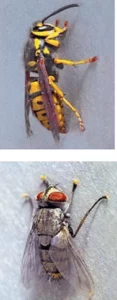
Yellow Jacket
Another bee that will swarm over if you stumble onto one of their nests. These guys will sting you in a heartbeat so be careful.
How to recognize : Adult wasps are 1/2 to 3/4 inch long, with characteristic yellow and black stripes and transparent wings.
Benefits Yellow jackets and other wasps are predators of caterpillars, flies and beetle grubs.
Concerns Yellow jackets are often feared for their sting, which is a hazard to people who are allergic. Some yellow jacket species are more likely to sting and scavenge at picnics than others. The scent of pears is a sting signal for yellow jackets. Scent of pears! You mean I should stop eating pears as I stroll the garden? What about pear flavored congac? Yes, pear flavored cognac is a real thing and also delicious.
Tachinnid Fly (above)
How to recognize : Resembling house flies, tachinid flies are 1/3 to 1/2 inch in length and may be brown, gray or black in color. Some species are very hairy.
Benefits There are many species of tachinid flies; many are parasites of pest caterpillars including cutworms, codling moths, tent caterpillars, cabbage loopers and gypsy moth larvae.
How to attract Adults feed on nectar, so plant flowers as well as herbs in the Umbelliferae family such as dill, parsley and Queen Anne’s Lace.
Creature Feature | Praying Mantis
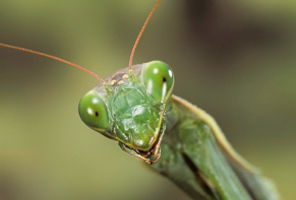
The insect scientifically known as a mantis or mantid seems to charm even the most bug-hating of people. The “praying” modifier was added by the public over time. It has large, raptorial front legs folded as if in prayer and a triangular head with almost inquisitive, bulging eyes that swivel to watch passers-by.
Soon after mating, a female praying mantis deposits a mass of eggs on a twig or other suitable structure. She may lay just a few dozen eggs or as many as 400 at one time. Using special accessory glands on her abdomen, the mother mantis then covers her eggs with a frothy substance, which hardens quickly to a consistency similar to polystyrene. This egg case is called an ootheca. A single female mantis may produce several oothecae (the plural of ootheca) after mating just once.
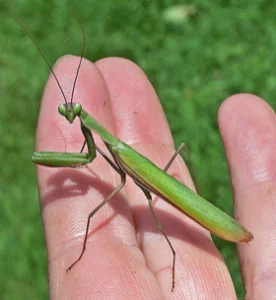
Praying mantises typically lay their eggs in late summer or fall, and the young develop within the ootheca over the winter months. The foamy case insulates the offspring from the cold and provides them with some protection from predators. Tiny mantis nymphs hatch from their eggs while still inside the egg case.
A mantis has a mobile head that can turn around like humans can, large eyes, large front legs to grab prey and four legs meant for walking. Praying mantids vary in adult length between 1 and 16 cm. Praying mantids exclusively eat other insects by catching them with their forelegs. They do not use poison but eat the prey alive while they hold it firmly.
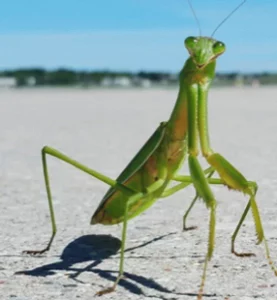
It has six legs, two wings and two antennae. The morphology, or body plan, of a praying mantis is similar to that of many insects. It has six legs, two wings and two antennae. However, they have some special features which makes them unique among insects. First they are able to turn their head around like humans can. All other insects cannot turn their heads, their neck is too rigid to allow it. Furthermore praying mantids have modified front legs; these front legs are especially designed to catch prey and hold them tightly. These arms are very strong and equipped with pointy spikes to keep a firm hold on the prey.
Most adult praying mantids have wings (some species do not). Females usually cannot fly with their wings, but males can. Some mantis species depend on good camouflage to prevent predators from eating them, while others keep a more simple look. Well camouflaged mantids have many projections on their body in the shape of dead leaves, branches, flower petals or even moss. Their colors can vary from brown, to green, white, pink, yellow or a mix of all colors. The more straightforwards looks are simply green, brown or sandy colored but without any special modifications.
Praying mantids are part of the hemimetabola group of insects; this means they do not undergo a complete metamorphosis. A complete metamorphosis is that of a butterfly or beetle; first you have a caterpillar or larvae, then a pupa (cocoon) and then the adult insect. This adult looks nothing like the first stage of the life cycle. In mantids and other hemimetabola, the newly born insects already resemble the adults.
In praying mantids, the newborn nymphs are almost the same as the parents except their size, color and their wings. These mantis nymphs shed their skin around 6 – 9 times before reaching adulthood. The number of molts depends on the species and the sex of the mantis. Every time the mantis sheds its skin, it will grow. Because of its rigid outer skeleton (skin) the mantis cannot grow in between molts.
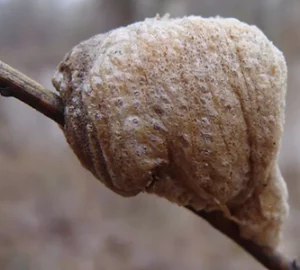
Every nymph stage is indicated with a number; newborn nymphs are called L1. After they shed their skin for the first time, they are called L2. This goes on until the mantis is almost adult. When it has only one molt to go before reaching adulthood it is often called subadult, although you could still indicate its life stage by its L-number.
Praying mantis eggs are deposited in the form of an ootheca; this is a cluster of eggs enclosed by foam. This foam will quickly harder after the female has produced the ootheca, thereby protecting the eggs inside from cold, predators and from desiccation.

Natural habitat and natural behavior– Praying mantis occur on all continents except Antarctica, therefore their natural habitat is very diverse. There are praying mantis species that occur in trees, bushes, grassland and even rocky or sandy desert environments. They can occur in wet ecosystems or in very dry systems. Their way of life strongly depends on its habitat and the species, but generally a praying mantis is a sit-and-wait predator. This means it will stay in one place and scan the environment for potential prey. When it spots its prey, some species will actively walk towards it to catch it. Other species will continue to wait until the prey is close enough to be caught.
When praying mantises become adult, the female will generally remain at her position while the male will search for her. The male is able to fly, while most female praying mantids are not. The female will emit a pheromone when she is ready to mate. The male can smell this pheromone of his own species from miles away and will fly towards her. Check out bugguide.net for more interesting info on the praying mantis.
Photos submitted by Ryan Tilley




























































